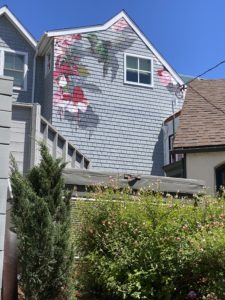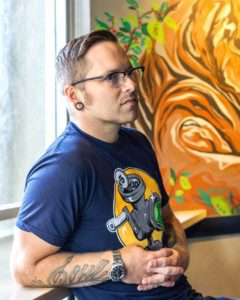 The latest one to appear in Glen Park is on one side of the home of the Schiraldis—Hilary, Mike and daughter Zelda (age 7).
The latest one to appear in Glen Park is on one side of the home of the Schiraldis—Hilary, Mike and daughter Zelda (age 7).
The family has lived on Laidley Street since 2009. The mural can be viewed up close on the east side of Castro Street between Laidley and Bemis Streets.
They thought the gray wall of their house was ugly and could be seen from many locations in the neighborhood: Diamond Street near BART, the Glen Park School playground, the pedestrian overpass on Bosworth, and the 280-N onramp. They wanted to put something on the wall that would make people smile.
The image is of a “Swingtime” variety fuchsia. Hilary explained the significance.
“We have a tree-sized specimen in our yard that neighbors tell us is 50 years old. Most of this variety was lost to blight in the 70’s, but this particular one survived. It seems to be nearing the end of its life, and we wanted to memorialize it, along with one of the Anna’s Hummingbirds who visit it frequently.”
The Schiraldis were helped in the process by Elise Boivin at Artly Owl, from interviewing artists to sourcing the scaffold.

The artist they chose is San Franciscan Cameron Moberg, who works in spray paint. He often uses themes of nature, positivity, spirituality, love, and hope, that will inspire others to persevere during hard times.
His work is on view on buildings in San Francisco, notably the Bayview, and the East Bay.
Moberg also teaches classes and curates gallery shows and art festivals focused on permitted graffiti and street art.
He reflected on painting this mural and his connection to the project:
“I have so many different connections to this piece and the neighborhood. I grew up filming skate videos for my brother at Glen Park School. They were on VHS camcorders, so I had to pause and start perfectly to get the right edits! Knowing that Mike and Hilary’s daughter goes there and you can see the mural from the house and vice versa is pretty cool. I too grew up with a fuchsia in my yard and would constantly watch the hummingbirds. For me it created a deeper connection to the mural, the wall, and the family.”